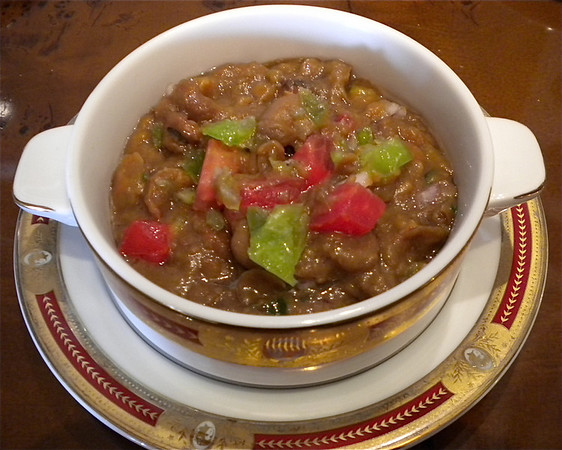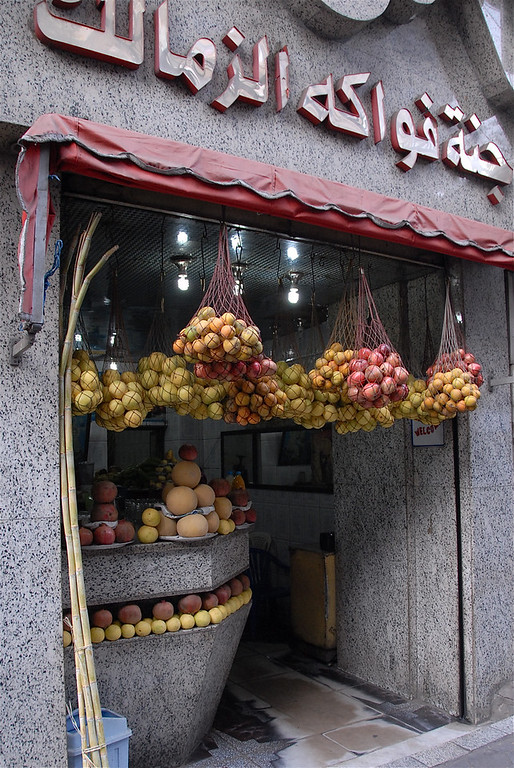
A pyramid at Giza, Egypt
As a child, I dreamt of becoming an international correspondent, dodging bullets to get the story that would change the world for the better. Instead of global strife I’ve ended up with a safer beat, covering culinary trends. Every now and then, though, my childhood fantasy collides with my adult reality and a place that I’ve visited or topic on which I’ve reported shoots to the top of the day’s headlines. Such is the case with Egypt.
Last fall I spent several weeks in this ancient North African land. During my stay I talked to locals about politics, education, and, of course, food. Strangely enough, I had known the least about the cuisine. Although I had researched it before leaving, I had found little on that topic for Egyptian cuisine often gets lumped under the heading of Middle Eastern or Mediterranean cooking. While both in the Middle East and along the Mediterranean, Egypt nonetheless possesses its own distinct flavors and history.

Ful medammes for breakfast in Egypt
Take, for instance, ful medammes. This traditional dish of fava beans dates back to the pharoahs, who made offerings of these and other legumes to the gods. Today the beans are boiled, mashed and mixed with onions, herbs and spices before being served to diners as breakfast or a snack. Start your day with a protein-packed bowl of ful medammes and hunks of soft pita and you’ll have enough energy to climb a pyramid or two.
Legumes pop up again in koushari. Featuring lentils and/or chickpeas, pasta, short-grain rice, onions and a spicy tomato sauce, koushari has been called the national dish of Egypt. You will find this hearty specialty in homes, restaurants and koushari stalls throughout the country.

Vegetable stew, rice and pita along the Nile
Also seen everywhere is shorbat molokhiya, a leafy, green herb soup. Native to Egypt, molokhiya reputedly cured a sickly, 10th century, Tunisian caliph of his illnesses. Rumor of the herb’s amazing curative properties spread across the land. Fearing shortages, Egyptian rulers forbade the lower classes to cook with it. Times have changed and you can enjoy this delicate soup anytime, anywhere. However, if herb soup doesn’t sound appealing, look for wholesome, vegetable-based stews. These stews or tageens frequently contain legumes as well as root vegetables such as garlic, onions and potatoes. Paired with rice or a salad and bread, they’re a meal in themselves.

Juice bar in Zamalek neighborhood of Cairo, Egypt
From what I experienced Egyptians seem to love sweets as much as I do. Creamy custards, honeyed semolina cakes and crisp filo pastries showed up everywhere from patisseries and upscale cafes to simple street stalls. One of the treats that I enjoyed the most was mahallabiyaa. Made from milk, ground rice, rose water, almonds, pistachios and walnuts, this light, cinnamon-dusted custard dates back to the era when corn wasn’t available in Egypt. Hence why this ethereal pudding was – and still is – thickened with ground rice.
The feasting doesn’t end with desserts. Among the common, healthful snacks enjoyed are roasted, sugar-coated chickpeas, toasted pumpkin seeds, fresh dates, figs and pomegranates. Likewise, seasonal smoothies and juice drinks made from bananas, mangoes, melons, cactus pears and carrots can be purchased on almost every main street.
FUL MEDAMMES
Serves 6
1 pound fava beans, shelled and skins removed
6 cloves garlic, roughly chopped
Juice of 1 lemon
1 tablespoon ground cumin
2 tablespoons parsley, chopped
1 teaspoon salt
Freshly ground black pepper, to taste
1-2 tablespoons olive oil
Pita bread, optional for serving
hard boiled eggs, optional for serving
Place the fava beans in a stock pot filled with 6 to 8 cups of boiling water. Boil the beans, uncovered, for 1 1/2 hours, then add the garlic. Continue to cook for another 30 minutes or so, until the beans are tender. During these 2 hours you may need to periodically add water. However, by the end of the cooking time, most of the liquid should have evaporated.
Remove from heat then mash the beans and garlic. Add the lemon juice, cumin, parsley, salt and pepper, and stir to combine.
Spoon the ful medamme into a medium-sized bowl and drizzle with olive oil. Serve alongside warmed pita bread and/or chopped hard boiled eggs.